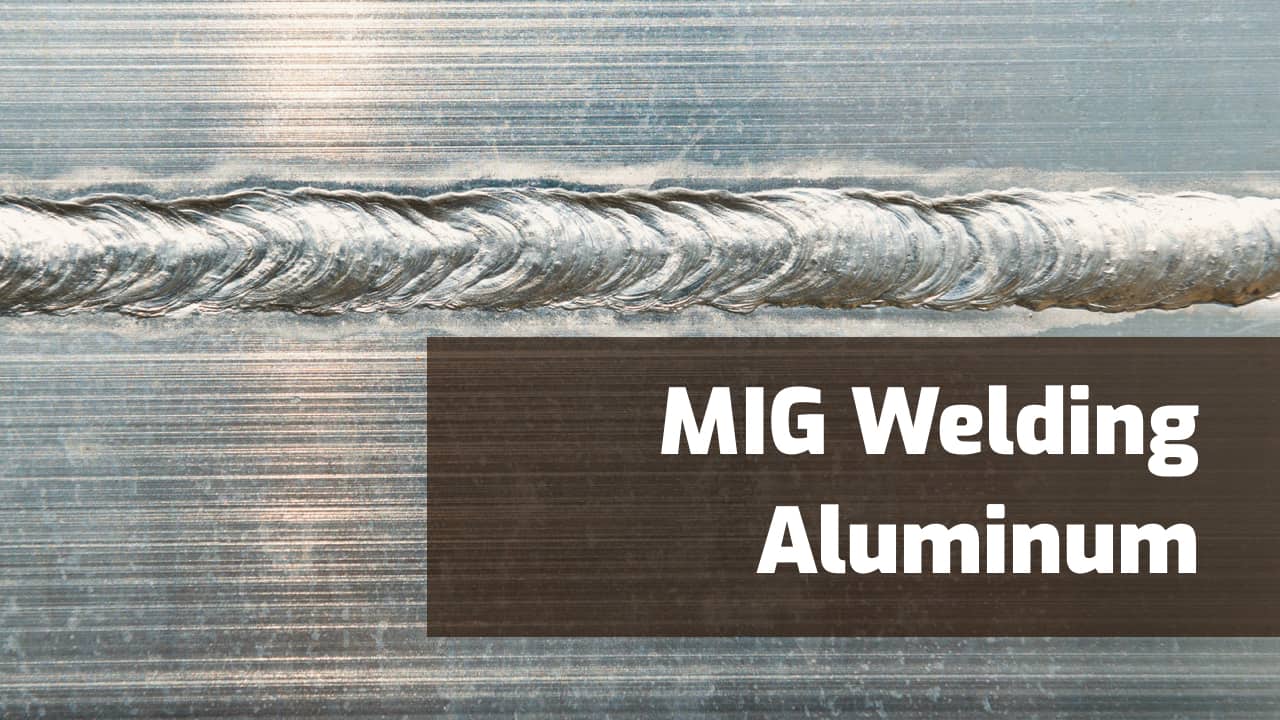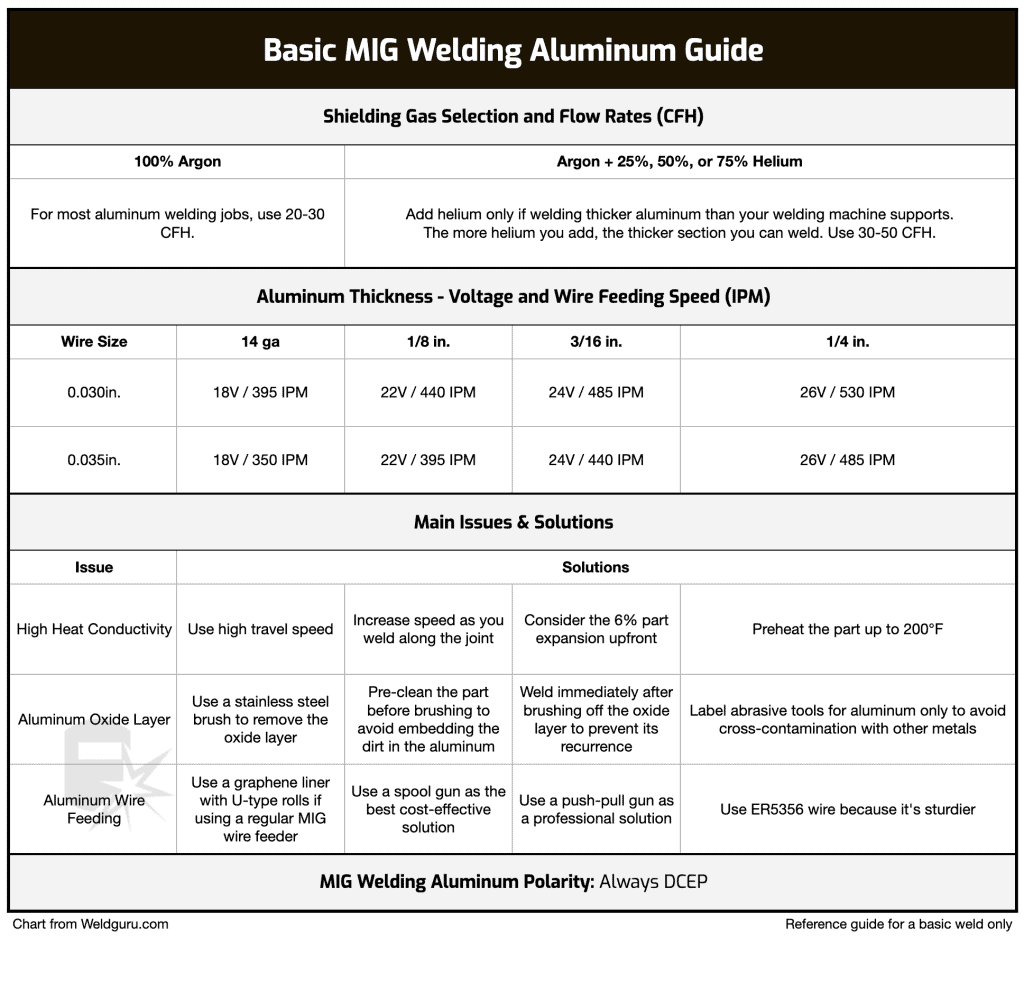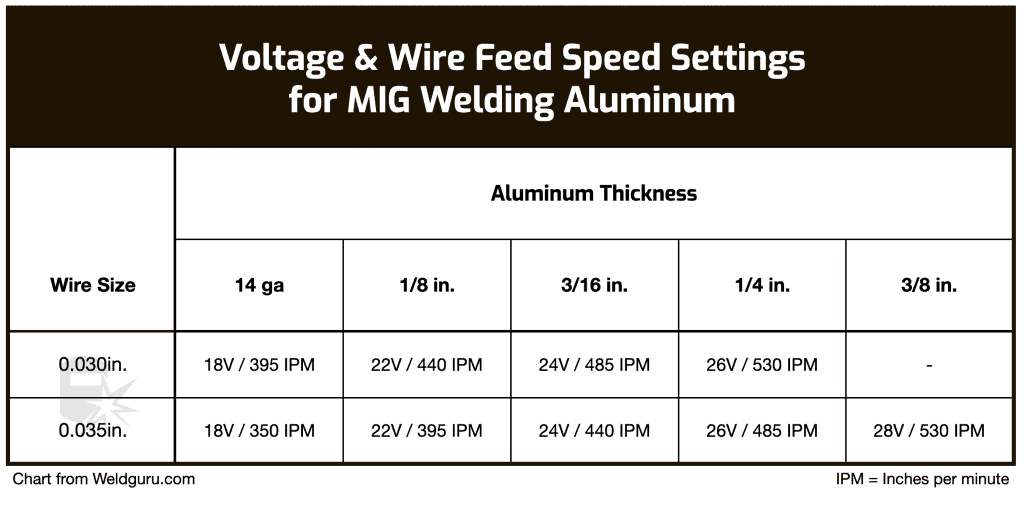Whether you’re a beginner or an experienced welder, this page has all the information you need to successfully weld aluminum using the MIG process.
From detailed settings charts that guide you through the intricate world of voltage, amperage, and wire feed speed, to a breakdown of the best aluminum MIG wire for various applications, I’ve got you covered.
Plus, don’t miss my tips that make the task of MIG welding aluminum not only achievable but also efficient. Let’s dive in!
MIG Welder Settings for Aluminum: Your Go-To Chart
Here’s your go-to chart for MIG welding aluminum settings. It’s a quick reference I put together to get you started, but remember that welding is both an art and a science.
While these settings provide a great starting point, there’s a lot more to consider for achieving the perfect weld.
Read on to:
- Pick the right accessories: Learn to choose the best wire and spool guns for your project.
- Step-by-step guide: From prep to technique.
- Overcome challenges: Navigate the difficulties unique to aluminum welding.
- Expert tips: Quick pointers to refine your skills and results.
Equipment & Materials: Choosing the Right Wire, Shielding Gas & Gun
Selecting the proper equipment and materials is pivotal for achieving a high-quality MIG weld.
From the type of wire and gun set-up to the correct shielding gas, every element plays a role.
Choosing the Right Wire
You’ll typically be working with 3000, 4000, 5000, or 6000 series aluminum. The filler metals most commonly used are ER4043 and ER5356, each with its own pros and cons.
ER4043 MIG Wire: This is your “general-purpose” aluminum filler metal, ideal for welding a variety of aluminum alloys such as 2014, 3003, 3004, 4043, 5052, 6061, 6062, and 6063. It’s a great all-rounder, known for its resistance to cracking and the ability to produce ductile welds. It’s an excellent choice for beginners or for those looking for versatility.
ER5356 MIG Wire: This wire is for more specialized applications. It has higher tensile strength, making it suitable for structural projects. However, it’s more prone to cracking and should be used with caution. The ER5356 is commonly used for welding alloys like 5050, 5052, 5056, 5083, 5086, 5154, 5356, 5454, and 5456.
| Aspect | ER4043 | ER5356 |
|---|---|---|
| Alloy Compatibility | 2014, 3003, 3004, 4043, 5052, 6061, 6062, 6063 | 5050, 5052, 5056, 5083, 5086, 5154, 5356, 5454, 5456 |
| Tensile Strength | Moderate | High |
| Crack Resistance | High | Moderate |
| Ductility | Moderate | High |
| Uses | General-purpose, versatile | Structural projects, higher strength required |
Selecting the Right Shielding Gas For MIG Welding Aluminum
MIG welding aluminum requires a 100% argon shielding gas or an argon-helium mixture. You cannot use the 75/25 Ar/CO2 shielding gas to weld aluminum.
Carbon dioxide cannot be present in the shielding gas because it’s a reactive gas. Even a tiny amount of carbon dioxide will devastate the aluminum and create a severely impaired joint.
Straight argon is typically used, and it’s the least expensive choice. However, if welding a thick piece of aluminum, adding helium to the mix increases the heat input, travel speed, and depth of penetration.
You can read all about shielding gases used for MIG welding in my separate article.
Choose A Gun & Wire Feeding Options
Feeding aluminum wire through a MIG gun can be challenging due to its softer nature compared to steel wire.
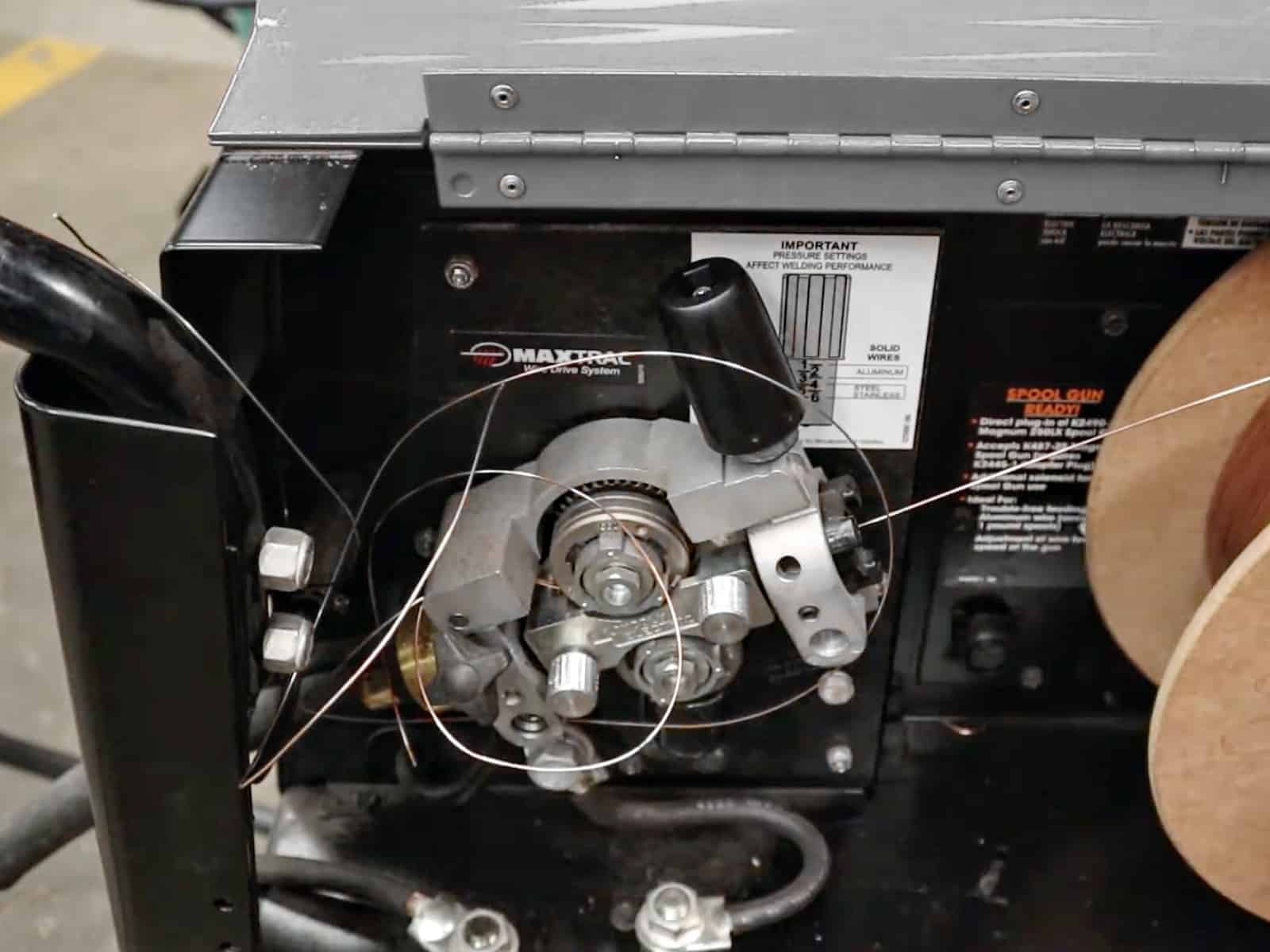
© weldguru.com – Image usage rights
This often leads to wire tangling or “bird-nesting” inside the feeder. For most people, using a spool gun is the best option to solve this.
But let’s take a look at all the options:
Spool Guns
- What Are They?: Spool guns are specialized MIG guns that have a small, built-in wire feeder capable of holding a 1-2 lb spool of wire.
- Advantages: They dramatically reduce the risk of wire tangling by shortening the wire’s travel distance.
- Limitations: These guns can be bulkier and heavier, making them less agile for intricate welding tasks.
Graphene Liner
- What Is It?: A graphene liner replaces the steel liner in your MIG gun and is made of carbon PTFE material.
- Advantages: It reduces friction between the wire and the liner, minimizing the risk of kinks and contamination.
- Limitations: While it reduces the risk of tangling, there is still a chance depending on how straight the lead is from the wire feeder to the MIG gun.
Push-Pull Guns
- What Are They?: These guns have a second motorized wire feeder built into the gun itself, which works with your main wire feeder.
- Advantages: Provides the most reliable wire feeding, especially for longer leads. Ideal for professional settings where consistent wire feeding is crucial.
- Limitations: These systems are more expensive and may be overkill for casual or hobbyist welders.
Note: if you’re going to buy a spool gun, make sure it’s compatible with your MIG machine.
MIG Welder Settings for Aluminum
Before you start MIG welding aluminum, knowing your welder’s settings is key.
Let’s take a look so you can get welding faster.
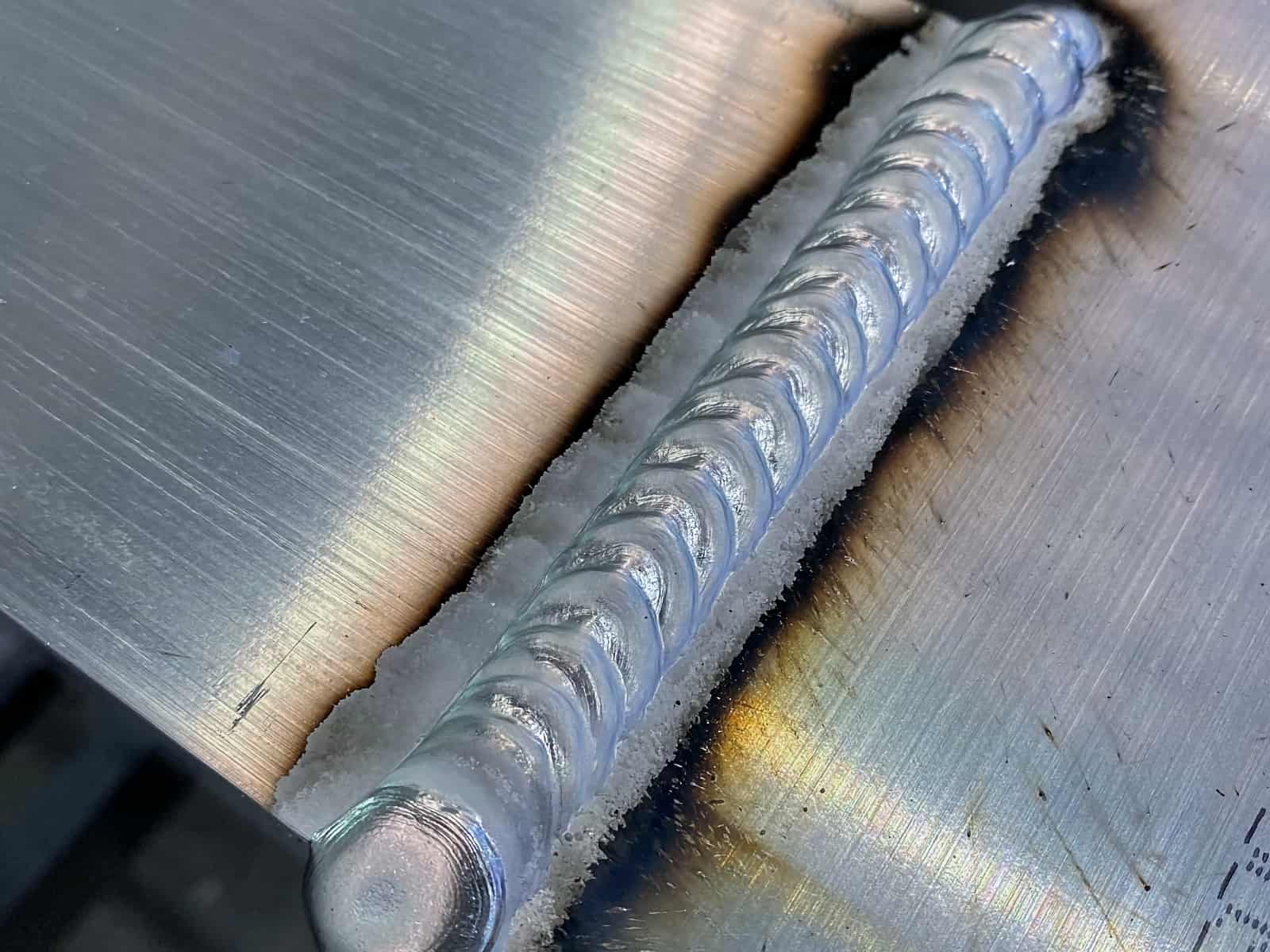
© weldguru.com – Image usage rights
Wire Feed Settings: Start Fast, Then Fine-Tune
Begin by setting your wire feed speed for aluminum 30-100% higher than you would for steel. This is a good starting point if your welder lacks a settings chart.
For exact settings, consult your machine’s user manual or your shop’s certified procedures.
Manufacturers often provide MIG settings charts; but here’s an example guide I put together if you don’t have one:
Set the Polarity: Stick with DCEP
For MIG welding aluminum, use direct current electrode positive (DCEP) polarity, just like you would for steel.
The only time you’d switch to DCEN is for flux-cored welding—so for aluminum, DCEP is your go-to.
Choosing the Amperage Output: Wire Speed Dictates
Higher wire feed speeds require higher amperage for deeper penetration.
The specific amperage varies between welder brands; for instance, a 400 IPM wire feeding speed may result in 200A in one machine and 180A in another.
Wire diameter also affects amperage: thicker wire needs faster wire speed for the same amperage.
Shielding Gas Flow Rate: Go High, Then Adjust
You’ll need a minimum gas flow rate of 20 CFH when using straight argon for MIG welding aluminum. If you notice porosity, ramp it up to around 30 CFH.
For mixes containing helium, you’ll need even higher rates—up to 50 CFH—due to helium’s lighter density.
Before Welding: Clean The Aluminum Surface
To successfully weld aluminum, you must first remove its oxide layer. Use a stainless steel bristle brush after cleaning the surface of all contaminants. Label your aluminum-only tools to avoid cross-contamination.
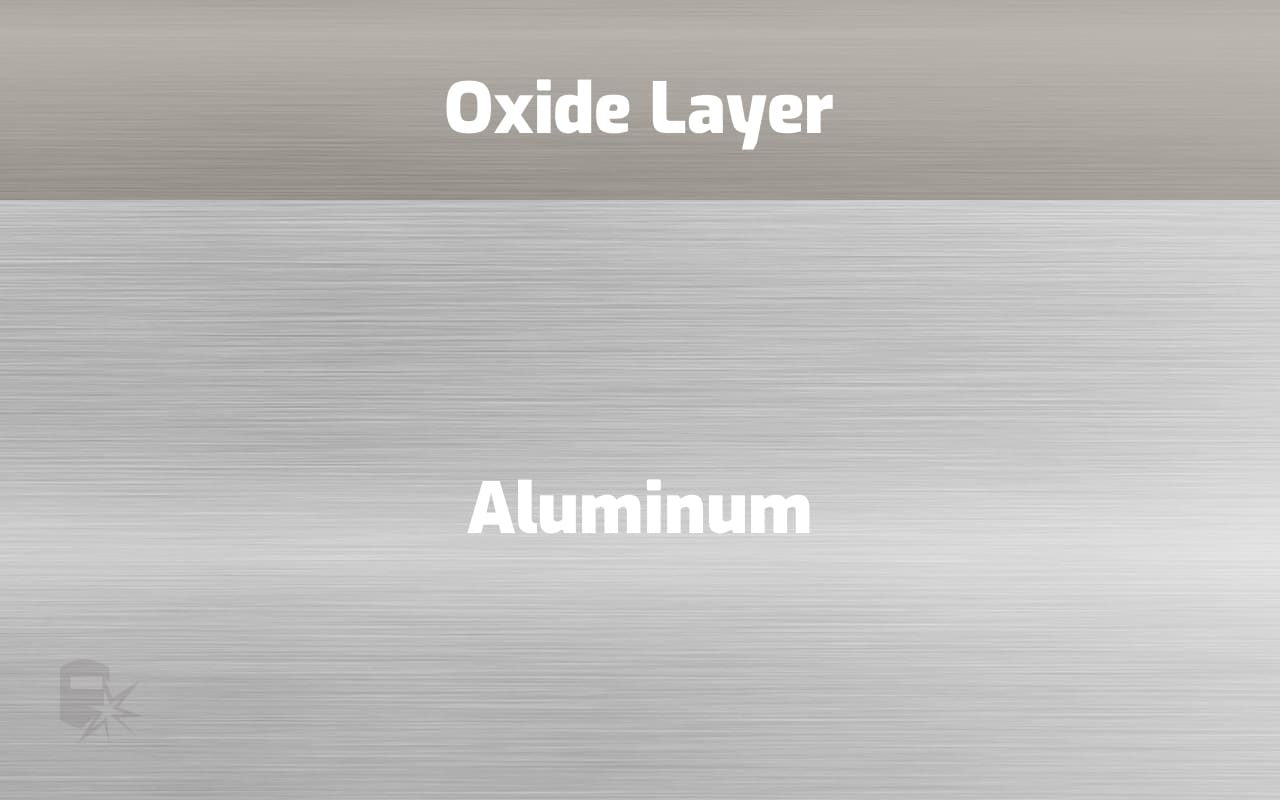
© weldguru.com – Image usage rights
Aluminum oxide forms a protective layer that melts at a much higher temperature than the base aluminum. This layer is crucial for the metal’s durability but poses challenges for welding. If not removed, it weakens the joint.
Before brushing off the oxide, ensure the aluminum surface is free from dust, paint, oil, and grease. Use a lint-free cloth and chemical solutions to clean the surface. Failing to do so will embed impurities into the metal, causing porosity during welding.
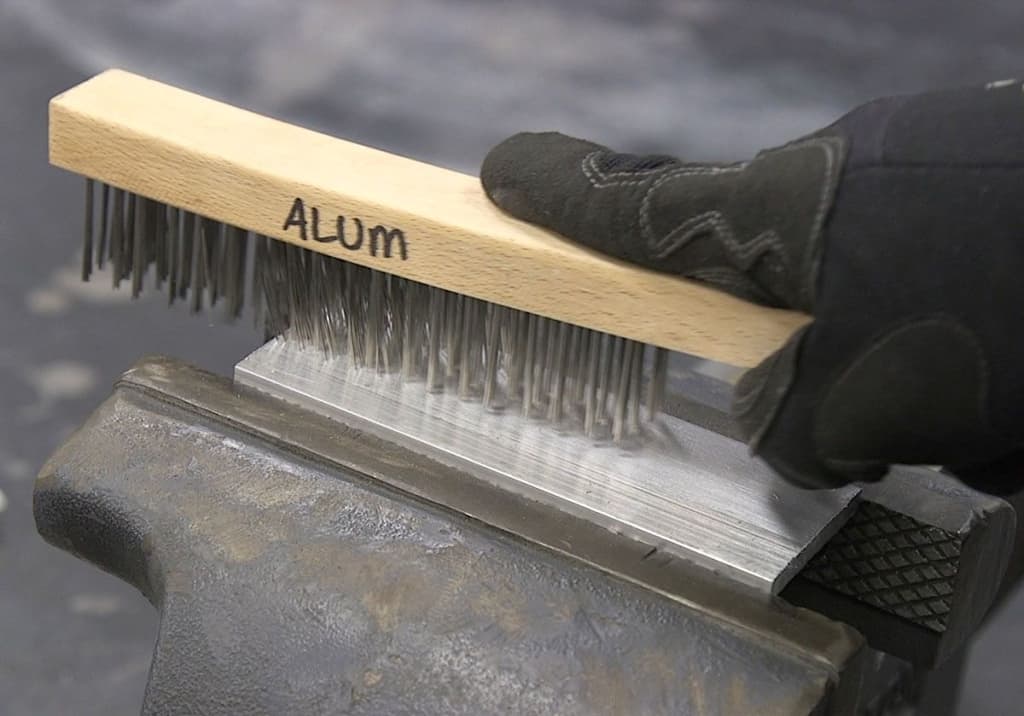
© weldguru.com – Image usage rights
Avoid using regular carbon steel wire brushes as they contaminate the aluminum. Instead, stick to a stainless steel brush specifically for aluminum work.
Label your tools and abrasives that come in contact with aluminum to prevent cross-contamination.
4 Welding Tips For MIG Welding Aluminum
The welding technique boils down to travel speed, torch angle, wire tip-to-work distance, and the MIG gun manipulation.
So, let’s discuss each to help you successfully MIG weld aluminum.
1. Watch Your Travel Speed
Since aluminum conducts heat rapidly, and the base aluminum melts at a relatively low temperature, you need to weld quickly.
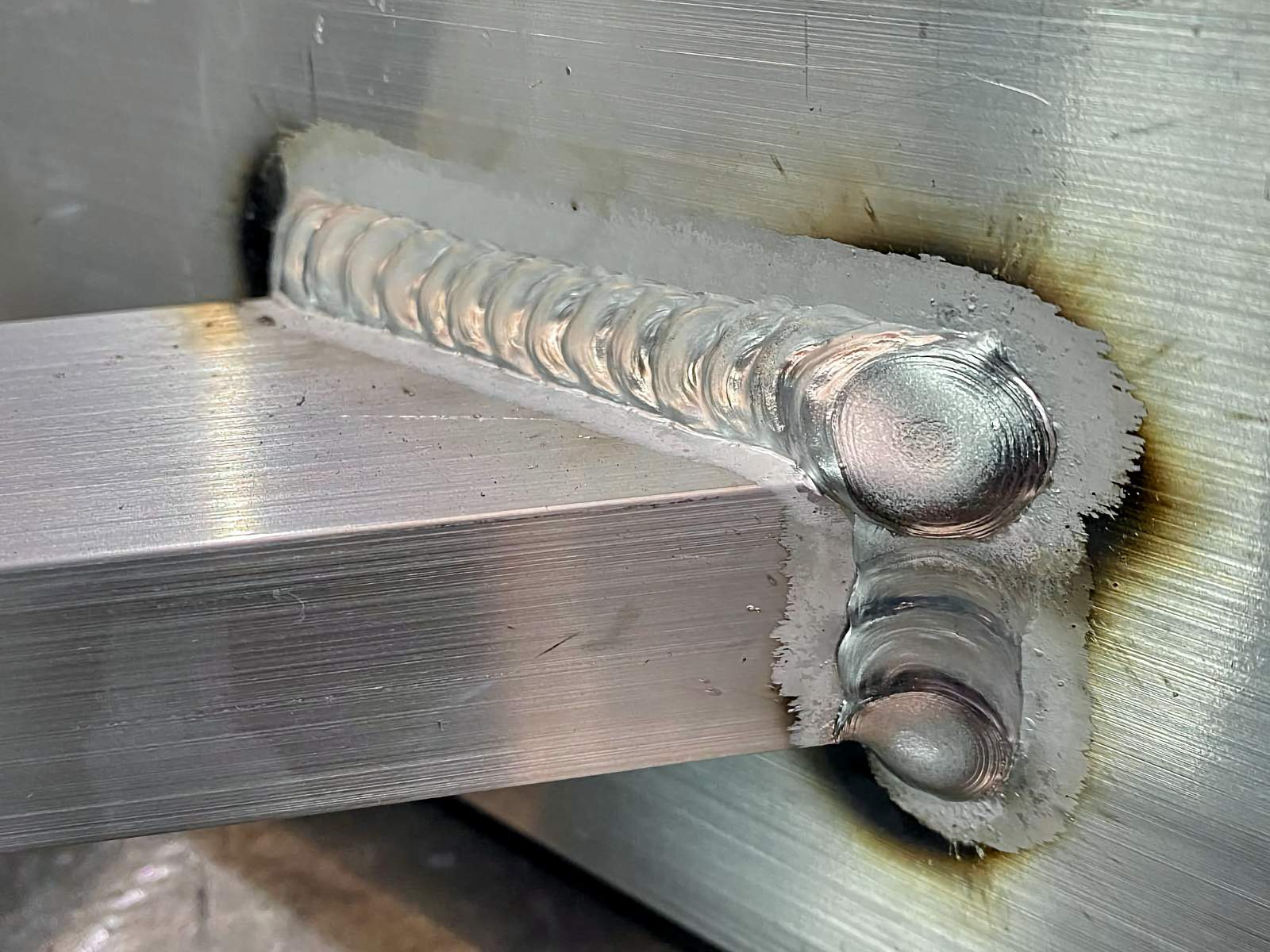
© weldguru.com – Image usage rights
Unlike TIG welding aluminum, which lets you take your time, MIG welding requires you to make the weld without delay. Prepare yourself, position the gun, and once the arc goes off, move fast until you reach the end of the joint.
The base metal will get heated as you weld if the joint line is long. This requires you to increase welding speed even more. You’ll burn through the metal with a uniform welding speed throughout the joint’s length, especially if welding thin aluminum.
It takes some practice to increase the travel speed as you weld correctly. So, don’t be discouraged if you fail at first.
2. Watch Your Torch Angle & Travel Direction
You should always use a push (forehand) travel direction with a 10-20 degrees angle to MIG weld aluminum.
If you try to pull the MIG gun, the shielding gas won’t provide sufficient coverage, and the welds will develop porosity.
Related: Should you push or pull when MIG welding?
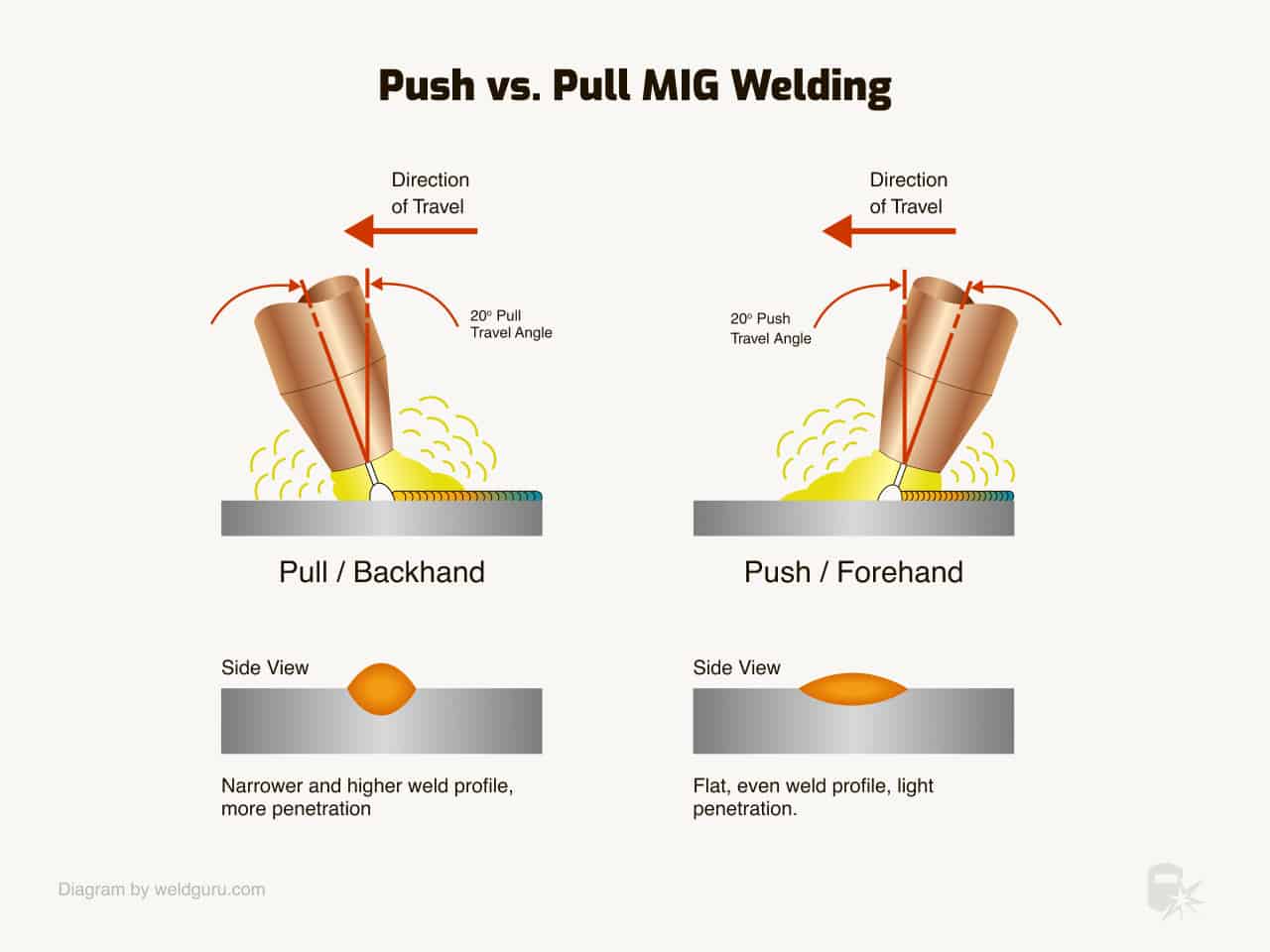
© weldguru.com – Image usage rights
It’s possible to drag the gun with the tip pointed in the opposite direction of pushing, but dragging risks dirty, porous welds.
Additionally, MIG welding aluminum requires a stringer bead. So, don’t weave the MIG gun because this reduces the penetration and fusion quality.
Related read: 6 MIG Welding Patterns To Master
3. Maintain Tip to Work Distance
A correct tip-to-work distance is about 3/4-inch. So, the MIG torch tip and workpiece gap is about 1/4-inch larger than when welding steel.
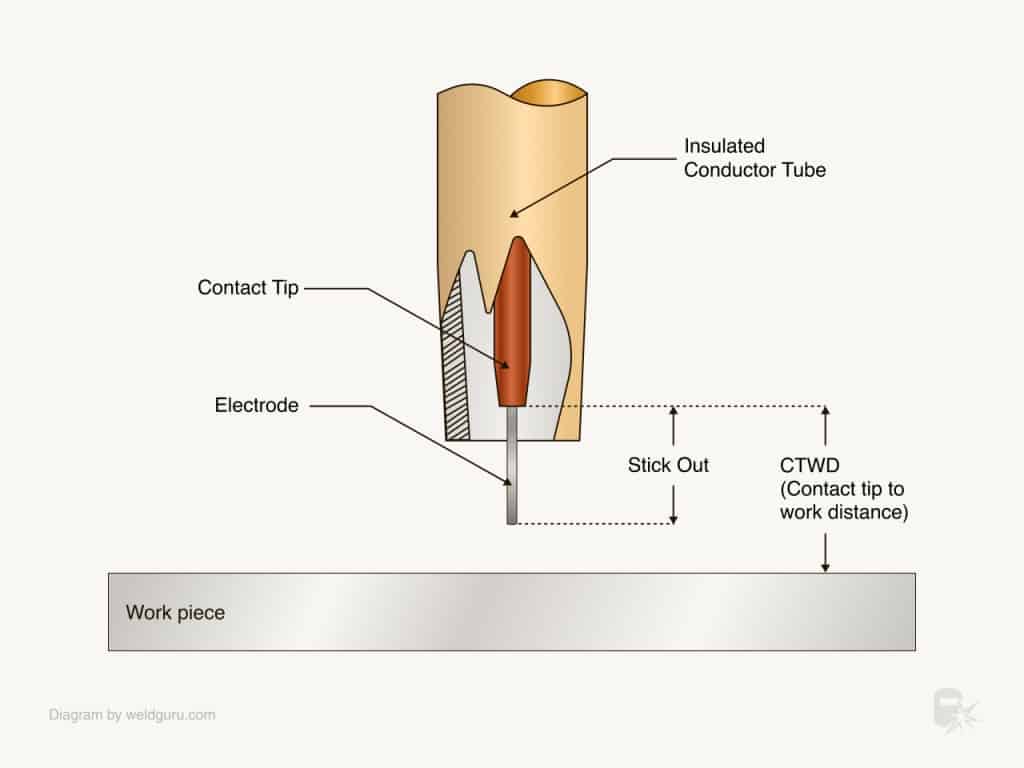
© weldguru.com – Image usage rights
Additionally, if possible, keep the contact tip recessed inside the nozzle about 1/8 inch. Otherwise, you risk the wire burning back to the contact tip because of the high reflective heat from the weld pool.
4. Use Spray Instead of Short Circuit Transfer
You should use a spray transfer mode to successfully MIG weld aluminum, not the short circuit transfer used for welding steel.
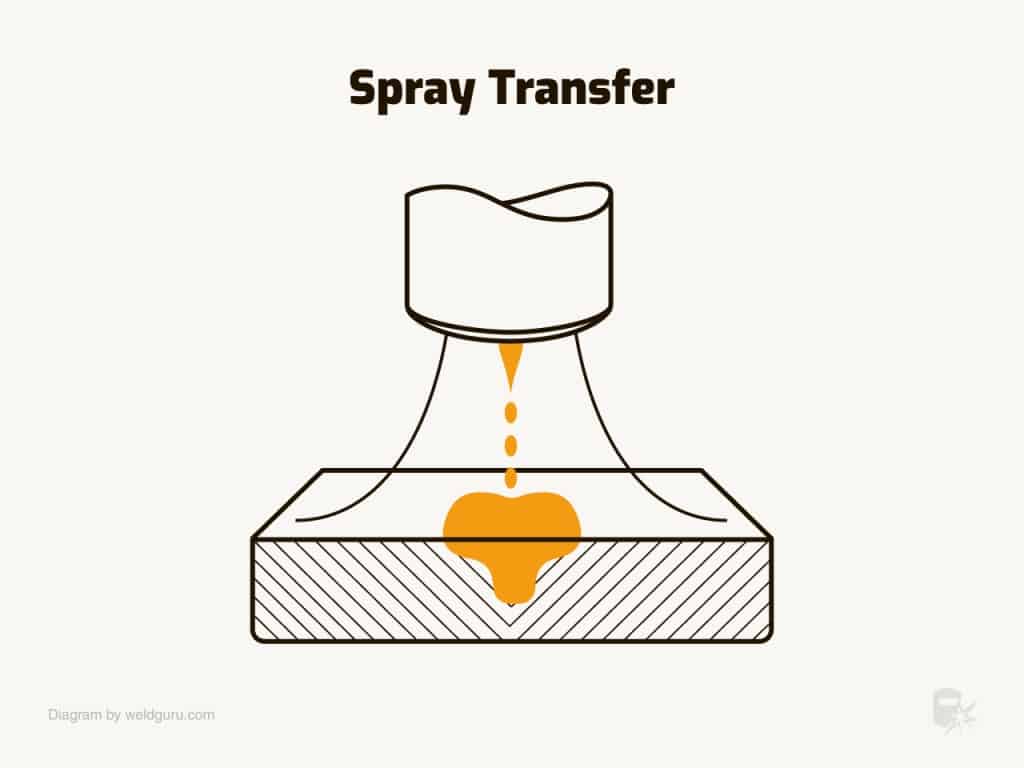
© weldguru.com – Image usage rights
Adjust your wire feeding speed and voltage higher than what you’d use for short circuit transfer. Be cautious, though; the high heat input can easily warp or burn through the material.
Spray transfer keeps the arc constant, depositing filler wire in tiny droplets into the weld pool. This results in a highly liquid weld pool, reduced spatter, and allows for high travel speeds.
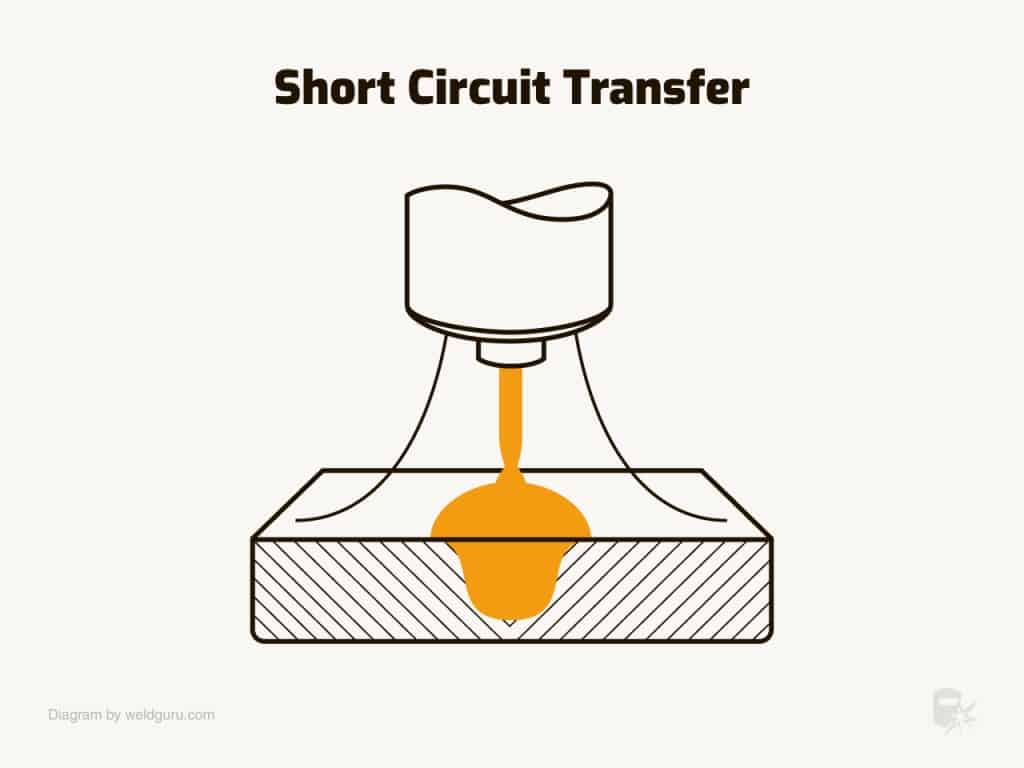
© weldguru.com – Image usage rights
The minimum voltage required for this is 20-24V, depending on the thickness of the welded part and your welding machine.
In contrast, short circuit transfer extinguishes the arc each time the wire touches the metal, initiating a new arc when more wire is fed.
This process happens multiple times per second and can be observed with the naked eye. While suitable for steel, it’s not ideal for aluminum due to inconsistent heat and filler metal deposition.
Want more tips? Read these 16 MIG welding tips.
Troubleshooting Guide for MIG Welding Aluminum
While you think you have everything set-up perfectly, you may still find issues with your weld.
Here are some common issues you might face while MIG welding aluminum:
Burn-Through (Melt Through)
Problem: Overheating the base material causes burn-through or melt-through.
Solution:
- Increase your travel speed and make shorter welds.
- Spread out the heat by moving around on the part.
- Consider using thicker material or changing the joint design.
- Eliminate or reduce gaps in the material.
Dirty Welds
Problem: Welds appear dirty or porous.
Solution:
- Use a push angle instead of a drag technique.
- Increase the voltage to get into spray transfer.
- Clean the base metal with a stainless steel brush.
- Ensure you’re using the proper shielding gas and wire alloy type.
Hot Cracking
Problem: Cracks appear in the weld due to high temperatures.
Solution:
- Choose a filler metal that results in a weld metal composition with low crack sensitivity.
- Opt for a weld-joint design that helps avoid a crack-sensitive weld composition.
- Be mindful of the base material’s susceptibility to cracking.
Stress Cracking
Problem: Cracks form due to excessive shrinkage rates during weld solidification and cooling.
Solution:
- Use a filler metal containing silicon to reduce shrinkage stresses.
- Increase weld-travel speed to narrow the heat-affected zone.
- Preheat the material to a temperature of 150°F to reduce residual stress levels.
Weld-Joint Porosity
Problem: Cavity-like discontinuities appear in the weld.
Solution:
- Identify and eliminate sources of hydrogen like paint, oil, and moisture.
- Use low-dew-point shielding gases and follow recommended flow rates.
- Clean the base metals thoroughly before welding.
Erratic Wire Feeding and Unstable Arcs
Problem: Wire feeding is inconsistent, leading to unstable arcs.
Solution:
- Use a power supply and consumables specifically designed for aluminum.
- Ensure the contact tip size matches the wire diameter.
- Use a U-groove drive roll in the wire feeder to prevent wire deformation.
Weld Discoloration and Smut
Problem: The weld appears discolored or smutty.
Solution:
- Use filler metals from the 4xxx series to reduce discoloration.
- Maintain a push angle to keep air out of the shielding gas.
- Increase the gas-cup size and keep it closer to the base metal.
Wrapping It
Aluminum is a complex material to weld, and using the MIG welding process whenever possible is preferred to TIG welding because it’s easier. Still, if you’ve never welded aluminum, you may think the entire process is too complex.
But, there are significantly fewer variables to consider when MIG welding aluminum compared to TIG welding. So, MIG welding is a good way for a beginner to dip their toes into welding this popular material.
MIG welding of aluminum is not as hard as some perceive it. With the know-how presented in this article, MIG welding allows you to tackle this common metal.
The key areas to focus on are aluminum precleaning, tuning in your MIG welder settings, and mastering your welding technique. You’ll get the hang of it with some practice.
Remember to make test welds on a scrap piece before welding something valuable. Welding is a skill, therefore the more arc time you get the better you will become.
Related Reads
TIG Welding Aluminum
Stick Welding Aluminum
Welding Aluminum To Steel – Can It Be Done?
